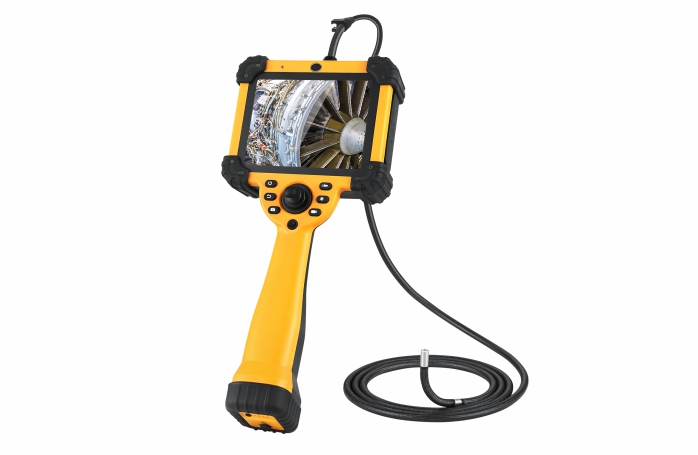Want to know more?
Don't miss any product updates on our industrial borescopes

Industrial borescope
solution service provider
Company Address
Office : 18F, Pingshanshouzuo, Pingshan District, Shenzhen,Guangdong
Contact Info
Ph: +86-0755-89588241

With the continuous development of thermal power generation technology, the capacity of single units and steam parameters are constantly increasing, and the equipment structure is becoming increasingly complex, which puts higher requirements on detection technology. As a non-destructive testing tool, industrial endoscopes play an important role in equipment inspection and maintenance of thermal power plants with their intuitive, efficient and accurate advantages.

Boiler pipeline inspection
Superheater, reheater, economizer pipeline: Industrial endoscopes can penetrate into high-temperature and high-pressure pipelines to detect defects such as pipe wall corrosion, scale accumulation, weld cracks, etc., to avoid pipe burst accidents.
Main steam pipeline: Use endoscopes to detect foreign matter and weld quality inside the pipeline to ensure smooth steam flow and reduce operating risks.
Steam turbine inspection
Rotor blades: Detect cracks, corrosion, scaling, etc. on the blade surface to evaluate the health of the blade.
Inside the cylinder: Check the welds and casting defects inside the cylinder to ensure the sealing and structural integrity of the cylinder.
Heat exchanger inspection
Inside the tube bundle: Detect scaling, corrosion, and blockage on the inner wall of the heat exchange tube to optimize the heat exchange efficiency.
Container equipment inspection
Deaerator, condenser: check internal corrosion, scaling, and foreign matter accumulation to ensure safe operation of the equipment.
High-pressure heater: check tube sheet welds and U-tube inner wall defects to avoid shutdown accidents caused by leakage.
Valve and pipeline accessories inspection
Valve cavity: check the wear and corrosion of the valve seat and valve disc sealing surface to ensure the valve sealing performance.
Flange connection surface: check the flange sealing surface defects to prevent medium leakage.
Fan and flue inspection
Fan blades: check the blade wear, cracks, and dust accumulation to optimize the fan efficiency.
Inside the flue: check the corrosion, wear, and dust accumulation of the inner wall of the flue to evaluate the service life of the flue.
Welding quality inspection
Internal quality of the weld: use an endoscope to detect defects such as fusion at the root of the weld, incomplete penetration, and pores to ensure welding quality.
Evaluation of heat treatment effect: check the changes in the structure of the heat-affected zone of the weld and evaluate the effect of the heat treatment process.
Foreign body evidence collection and location
Foreign bodies inside the equipment: Use endoscope to locate and record the position of foreign bodies inside the equipment, providing a basis for foreign body cleaning.
Wear particle analysis: Detect wear particles inside the equipment, analyze the cause of wear, and optimize lubrication and operating parameters.
Online monitoring and status assessment
Equipment operation status monitoring: During equipment downtime and maintenance, use endoscopes to quickly detect key parts and evaluate the health status of the equipment.
Defect development trend tracking: Compare and analyze historical inspection data, track defect development, and formulate preventive maintenance plans.
Application of new inspection technologies
3D measurement endoscope: Through 3D modeling technology, accurately measure defect size and provide data support for maintenance decisions.
Robot-assisted inspection: Combined with crawling robots, it realizes automated inspection of complex pipelines and containers, improving inspection efficiency and safety.

Non-destructive testing: No need to disassemble the equipment, reduce downtime and maintenance costs.
Intuitive and efficient: High-definition imaging technology can clearly display internal defects of the equipment and improve detection accuracy.
Safe and reliable: Inspectors do not need to enter dangerous areas to ensure personal safety.
Data traceability: The detection process can be recorded and photographed to facilitate defect analysis and quality traceability.
Intelligent detection: Combined with artificial intelligence technology, automatic identification, classification and evaluation of defects can be achieved.
Remote collaboration: Remote detection and expert consultation can be achieved through 5G technology to improve detection efficiency.
Multimodal fusion: Combined with other non-destructive testing technologies such as ultrasound and eddy current, comprehensive evaluation of multiple parameters can be achieved.
Industrial endoscopes have become an important tool for equipment inspection and maintenance in thermal power plants. With the continuous advancement of technology, its scope of application will be further expanded, providing strong guarantees for the safe and efficient operation of thermal power plants.

Industrial borescope
solution service provider